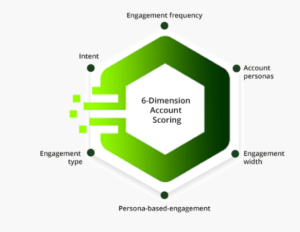For ABM programs to deliver on revenue goals, sales and marketing must align. Although marketing is often viewed as the primary stakeholder in ABM, actual ABM implementations reveal a different story.
Buying journeys are no longer linear and buyer group sizes are expanding.
According to Gartner’s insights on B2B buying journey- The typical buying group for a complex B2B solution involves six to 10 decision makers, each armed with four or five pieces of information they’ve gathered independently.
To orchestrate seamless buying journeys, sales and marketing teams need to feed into each other. For example, the type of accounts that convert quickly becomes model accounts. ABM accounts are prioritized based on insights gained while converting these model accounts.
Clearly, all of this seems very complex. So, how do you collaborate and strategize your ABM program?
Account scoring: A window into a buyer’s journey
In the MQL era, we would spray and pray with some marketing tactics and measure a random activity for a random score based on the prospect deciding to do something. The scoring method was called lead scoring. However, how would lead scoring work if there were multiple prospects doing different engagement activities within the same account?
Why is it difficult to score accounts accurately?
Lead scoring is a good start. It enables marketers to get an idea of the buying interest and whether the individual belongs to the buying group. However, it doesn’t offer a comprehensive indication of the fit, current state and interest signals. So, we started scoring accounts to ensure we are running after the right ABM list.
If marketing and sales are to view an account objectively and accurately, a comprehensive account scoring model is required. It should result in early-stage opportunities that SDRs and sales teams can validate and close quickly.
However, account scoring remains a source of contention across and within companies. Let’s explore some of the reasons for this.
-
A lack of clarity on the ICPs
The first step, for marketing and sales, is to agree on what an Ideal Customer Profile is. Or what the attributes of their model account are. With a clear definition of the ICP, revenue teams can decide what the most important attributes are and what values to assign them.
By doing this, we will be able to create an aligned and trusted scoring and prioritization process. In spite of the fact that every company’s definition of an ICP changes as the company grows, having a common understanding is essential to getting the right account scoring.
-
The complexity with measuring multiple attributes
When you start scoring accounts, you realize there are just too many factors to consider. From firmographic attributes like number of employees and annual revenue to technographic details like martech stack.
Everything isn’t just as simple as weighting all attributes and adding them together. Current state and interest signals become the predominant attributes for accurate account scoring. Whether an account is in-market and how actively it is researching for solutions similar to yours are important signals. For signals like these, the traditional point-based scoring isn’t enough. A more sophisticated AI-based algorithm that enables predictive analytics and data-driven scoring becomes necessary.
-
A lack of a single view of account engagement
It is important to remember that all buying signals are not equal. The differences in buying signal strength could depend on the marketing and sales activities, the channels leveraged and the personas engaged.
You’ll also have to factor in the wide range of activities you’ve been orchestrating across channels to engage your target audience. It is important to rate these activities and channels in order of their intent strength.
As an example, would you consider email engagement more high-intent than organic website visits? Wouldn’t it also depend on the message of the email, type of campaign or the type of content on the page? But a CxO engaging in either case could be the clear winner.
-
Inability to determine the best time to contact an account
For revenue teams, everything is a race against time. If you don’t act on buying signals when they’re hot, you just might miss the opportunity bus. All types of intent signals – first, second and third party have to be measured relative to time.
It is then critical to have thresholds for determining when to pass an account to the next stage. A common way to ensure timely handoffs from one team to another is to adopt Service Level Agreements (SLAs). Factoring in scoring thresholds in terms of SLAs will help revenue teams avoid false-positives.
Scoring accounts the BambooBox way
In the world of sales and marketing, people dream about high-intent accounts ripe for SDR outreach filling up their funnels. At BambooBox, we call such accounts Potential Opportunities (PO).
POs are accounts that BambooBox’s AI-powered algorithm has prioritized for you to contact. BambooBox offers a more nuanced and contextual approach to account scoring. It offers a 6D approach that considers fit, current state and interest signals.

-
Align on your ICP
The first struggle in firing up an ABM program is ensuring sales and marketing are aligned on the accounts to target. Agreeing on the ICP makes everything so much easier. BambooBox enables you to configure your ICP and identify accounts that match it. This is the first and foremost level of scoring within our system.
You can keep sharpening your ICP as your GTM strategy evolves. BambooBox supports multi-product GTM motions through multiple ICP configurations for all your verticals of offerings. As well as the full gamut of lifecycle revenue marketing.
-
Account engagement at a glance
Your engagement signals are the best way to confirm if your accounts are in the buying journey. This is provided your messaging and channels are relevant.
Be absolutely clear on the type of message that your target accounts and personas are interested in. With BambooBox, you can assign different engagement values to activities such as email opens, clicks, social engagement, etc. Ultimately, all these will come together to establish an engagement level for each account.
-
A platform that works on context and timing
The BambooBox model scores accounts on the basis of frequency of engagement. An account in the PO stage will not remain in that stage if it stops engaging with your activities or stops showing intent.
There is a certain threshold for each buying signal within the BambooBox scoring system. If left unengaged, accounts will fall back to more premature stages. This is where our actionable insights kick in. It offers clear insights that marketers need to continuously act on to further push accounts down the funnel in a timely manner.
-
Get the engagement going to keep accounts nurtured
The only way to determine engaged accounts’ interest in your message is through first-party data, so you need to test your hypothesis as much as possible.
Expand your activities across channels to ensure you are validating their buying interests in different ways. BambooBox’s account score is influenced by the number of activities an account engages in.
-
Get the whole buying committee involved in the process
It is as important to know ‘who’ within the account engaged with your campaigns as much as ‘which account.’ Do any of the engaged contacts actually belong to the buyer group? Is the engaged persona a user, an influencer or a decision-maker?
One of the dimensions in the 6D scoring system is persona-based engagement. Accounts are scored depending on the personas that are engaging. It also matters whether there are enough buying group members engaged within the account.
-
Catch accounts faster in their buying process with 3rd party intent signals
While third-party intent data uses are myriad, it could also be a great validation of your engagement signals.
Imagine you’re pitching an ABM solution through your campaigns. You find that the accounts that engage with your campaigns are also surging for ABM platform related topics. This means they are actively researching ABM and ABM platform related topics across the web.
Make your account scoring model more contextual
Account scoring is an ongoing process that helps marketers identify accounts to include or exclude from their target list. And decide when is the right time to pass them on to SDRs for the first human interaction.
The models for scoring accounts will vary from company to company. Any scoring system can measure signals that clearly indicate movement or change in buying activity. Account scoring systems need to evolve beyond the traditional point-based approach. The AI-based BambooBox scoring engine offers a more automated and scalable approach for marketing and sales to interpret buying signals at a more contextual and granular level. This enables marketers to quickly scale their ABM programs while keeping them targeted too.



